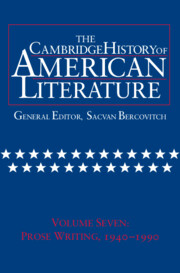Book contents
- Frontmatter
- Introduction
- The Drama, 1940—1990
- Fiction and Society, 1940–1970
- 1 War and the Novel: From World War II to Vietnam
- 2 The New Fiction: From the Home Front to the 1950s
- 3 On and Off the Road: The Outsider as Young Rebel
- 4 Apocalypse Now: A Literature of Extremes
- After the Southern Renascence
- Postmodern Fictions, 1960–1990
- Emergent Literatures
- Appendix: Biographies
- Chronology, 1940–1990
- Bibliography
- Index
4 - Apocalypse Now: A Literature of Extremes
from Fiction and Society, 1940–1970
Published online by Cambridge University Press: 28 March 2008
- Frontmatter
- Introduction
- The Drama, 1940—1990
- Fiction and Society, 1940–1970
- 1 War and the Novel: From World War II to Vietnam
- 2 The New Fiction: From the Home Front to the 1950s
- 3 On and Off the Road: The Outsider as Young Rebel
- 4 Apocalypse Now: A Literature of Extremes
- After the Southern Renascence
- Postmodern Fictions, 1960–1990
- Emergent Literatures
- Appendix: Biographies
- Chronology, 1940–1990
- Bibliography
- Index
Summary
Historian E. J. Hobsbawm has described the twentieth century as the age of extremes. In a strange way, no quarter of the century had to grapple with extremity, or its terrible aftermath, more than the seemingly tranquil decades after the Second World War, which some Americans still look back on as a golden age. Though the war had spared the North American continent, its effects were brought home as Americans emerged from their traditional isolation. Besides coming to terms with the general carnage on an unheard of scale, and moving rapidly toward the reconstruction of Europe and Asia, the postwar world had to assimilate the most shocking news of the war, perhaps of the century as a whole: the details of Holocaust and the effects of the atomic bomb. The Holocaust and the bomb do not often explicitly appear in the literature of the forties and fifties, perhaps because writers found them too large to encompass and too remote from their direct experience. Despite this eerie silence, they contributed to an undercurrent of anxiety that was freely reflected not only in poems and novels but in the popular culture, including horror films, science fiction, and the new vogue of ghoulish comic books that alarmed the moralists and psychologists of the period. Along with peace and prosperity came a heightening of anxiety and insecurity.
Ordinary Americans, insulated from immediate knowledge of the worst horrors of the war, recoiled after 1945 into an island of normalcy, a world of getting and spending, as they had done after the First World War. There was an emphasis on family and domesticity, on traditional gender roles, and on a new culture of consumption made possible by rapid economic growth. The war industries retooled to produce consumer goods, beginning with new homes and cars.
- Type
- Chapter
- Information
- The Cambridge History of American Literature , pp. 224 - 310Publisher: Cambridge University PressPrint publication year: 1999



